To drive by car to Reszel, the former German Rößel, you need a lot of time and good tires. The remote little town doesn’t want to show its face at first. But once you have arrived, you can experience a beautiful old town, the highlight of which is an old castle. Here, where the border between Warmia and Masuria runs, time seems to have stood still. Also the location at the small river Sajna and the dark forests surrounding the town provide a wonderful flair. So it is high time to introduce you to one of the most beautiful sights of Masuria.
History of Reszel
In the Middle Ages, the area around Reszel, like the entire region, was populated by the Old Prussians, a pagan ethnic group. The Teutonic Order, which was called into the country to christianize it, then established an outpost here. After it was attacked several times, the construction of a stone castle began and more and more people settled here. The city continued to grow, despite the political turmoil. When the First Polish Division took place and the region fell to Prussia, Reszel had over 3000 inhabitants. Thus, after Braunsberg (Braniewo) and Heilsberg (Lidzbark Warminski), it was the third largest city in the once independent state of Warmia and almost twice as large as today’s capital Olsztyn!
Devastating fire and resurrection
Reszel was hit hard in 1806, when a fire almost completely destroyed the village. But this also offered the chance for reconstruction and the Prussian king Friedrich Wilhelm III. commissioned none other than the famous master builder Karl Friedrich Schinkel to build a new castle chapel.
The 20th century
During the First World War, East Prussia and thus the region of Reszel was the only area of the German Empire on which warfare took place. When the Battle of the Masurian Lakes took place, Hindenburg and Ludendorff had their quarters in Reszel and for some time successfully coordinated military action against Russia from here.
The last months of the Second World War had devastating consequences for Warmia and Mazury. However, Reszel seems to have survived the war almost unscathed. This is certainly also due to its location away from the main traffic routes. After the war, the German population was displaced, unless they had already fled anyway. Polish settlers arrived and the town grew again in the following years. Today, however, Reszel seems rather sleepy, partly because there is a lack of prospects for young people and jobs, and many tend to move to the regional center of Olsztyn.
Walk through the city

Gothic bridge
Access to the city is usually via its eastern side, where a Gothic brick bridge, parts of which date back to the 14th century, crosses the river. Below the bridge there is a small park from which you have the best view of the massive structure.
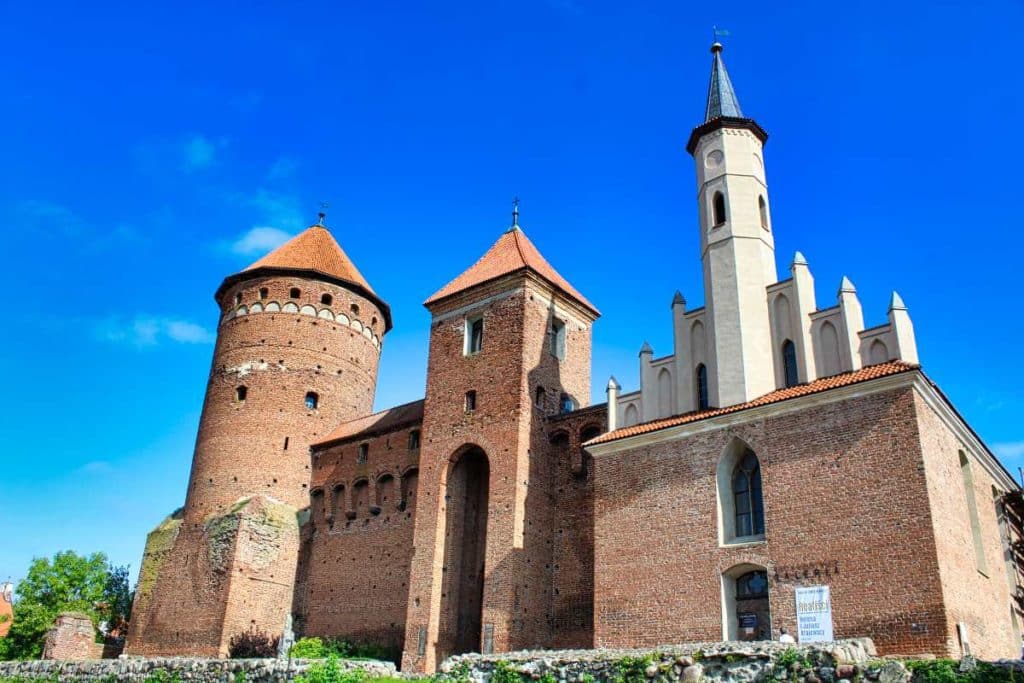
Bishop’s Castle
Already in the 13th century there was a castle in Reszel, but it had been destroyed twice by Prussian horsemen. Therefore, in the 14th century under Bishop Johann von Meissen a castle was built, which was administered by a burgrave until the First Polish Division (1772). Later the castle served mainly as a prison.
Best view of the city
The castle is worth seeing and is one of the architectural pearls of Warmia. As soon as you enter the secluded courtyard of the complex, you feel like you are transported back to the Middle Ages. First you pass the high gate, which has a red tiled roof similar to the keep. The keep next to it has a rectangular ground plan and is round at the top – a typical feature of the Warmia castles of that time. The upper part was only built in the 16th century to defend the castle with firearms. From the keep you have the most beautiful view of the parish church, as the picture shows.
Museum with dark history
The tower also houses an exhibition that provides information in English and German (and in a very drastic way) about the history of torture using numerous “instruments”. The reason for this is that in 1811 Barbara Zdunk, the last “witch” in Europe, was burned at the stake in Reszel. Before that she had been held prisoner here for four years and tortured. The reason for this: She was blamed for the city fire. Another small exhibition in the main wing of the castle deals with knights.
Modern art in old walls
Much more peaceful than the torture exhibition is the modern art exhibition housed in the former castle chapel. It is part of the State Museum and the museum is known far beyond the borders of the region. Here you can admire works of both Polish and international artists.
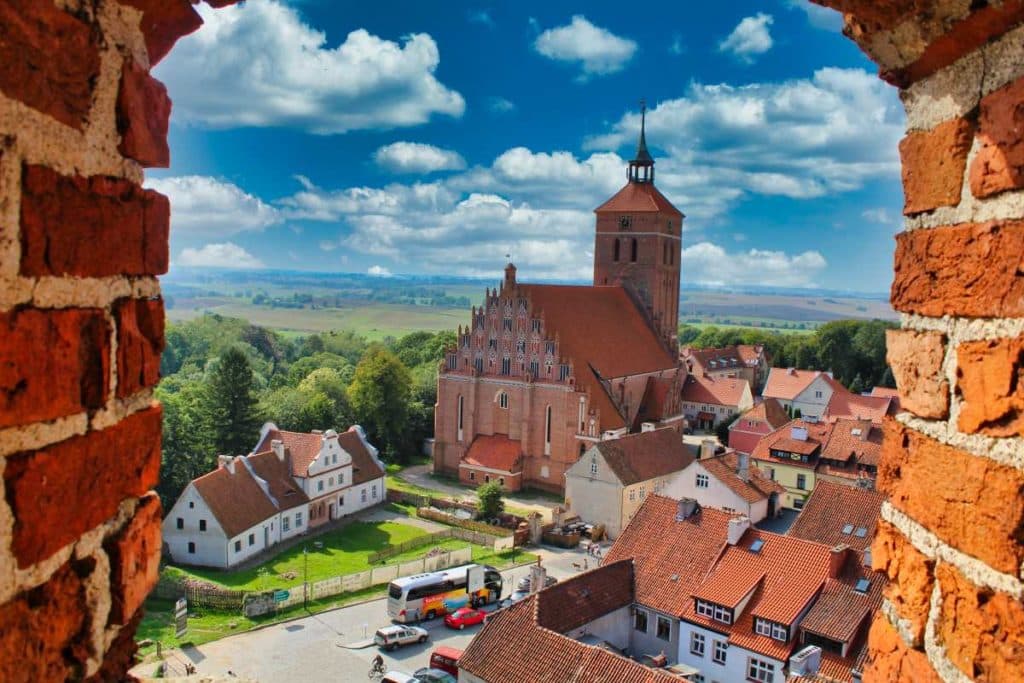
Parish church
A vault like the canopy of heaven
The parish church of Reszel was built between the late 14th and early 16th century. The three-nave hall church has octagonal pillars that hold the wonderful star vault created by Niclas Scheunemann, which runs through the entire church. The interior is rich in cornices, gables and small decorations, all of which date from the late Middle Ages. Above the entrance, the church also has a gold-plated organ worth seeing. A small library was later added to the east side of the church, which has a remarkable barrel vault.

The Altar – a masterpiece
During the great town fire of 1806, the church was also damaged and subsequently received a new interior decoration, including the high altar created by Wilhelm Biereichel with paintings and figures by Christoph Peucker, Isaak Riga (court sculptor of the Duke of Prussia and one of the most important woodcarvers of his time) and Anton Johann Blank, who was born in Olsztyn, so that today the interior has both Baroque and Classicist elements.
Observation tower
On the west side of the church there is a huge tower, eight stories and 52 meters high. From here you have the best view of the castle and the old town market, so the 250 steps and the low entrance fee are well worth it!
Next to the church lays the former residence of the archpriest, a building from the 15th century that was lavishly restored in 2019 and was still in a state of decay a few years ago.
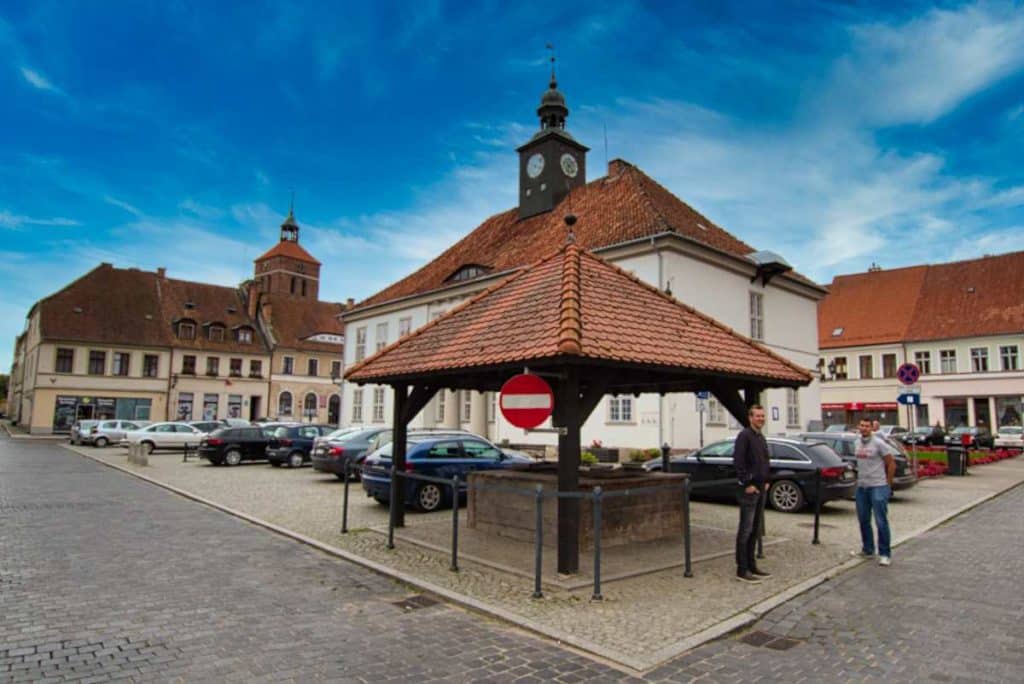
Market Square
The actual core of Reszel, with its almost entirely historical buildings, extends over a square area measuring only about 200 x 200 meters. After a fire in 1806, the town had to be almost completely rebuilt and at that time it received its classicist appearance, which can still be admired today. In the center of this area there is the marketplace of the city.
A town hall with an unusual roof
The most beautiful building on the square is the Town Hall, built from 1815 or 1816 on the foundations of the old gothic town hall, a two-storey white building with a portico with two columns at the entrance and a sweeping roof, in the middle of which, since the building was erected, a tower clock with a point reliably indicates the time.
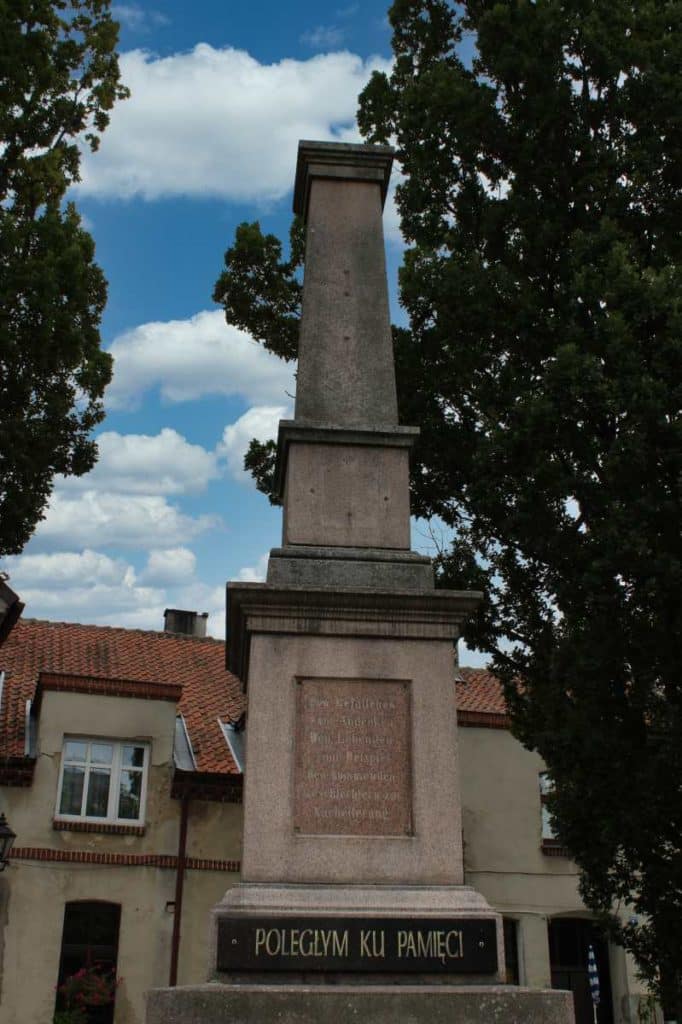
A war memorial as a sign of reconciliation?
North of the market place there is an old German war memorial, which was not demolished after the war, but was supplemented by a Polish plaque, so that now German and Polish war victims are commemorated in a certain sense equally.
Food and Drink
- Restauracja Zamkowa, tel. +48 89 7550109. Classics of Polish cuisine are served in the castle courtyard or its vaults. There is also a bar, which is often open until the early morning hours.
Overnight stay
In the castle there is an animal and family friendly hotel. The 20 rooms are equipped with modern comfort and are individually adapted to their gothic surroundings – the perfect setting for your Reszel visit!
Alternatively, you can book accommodation through Airbnb*, which also offers many family accommodation options in the surrounding area.
Trips to the surrounding area
For the visit of Reszel you should plan about half a day. Afterwards you can drive to two important sights, which are already in Masuria and can be reached by car in a few minutes.
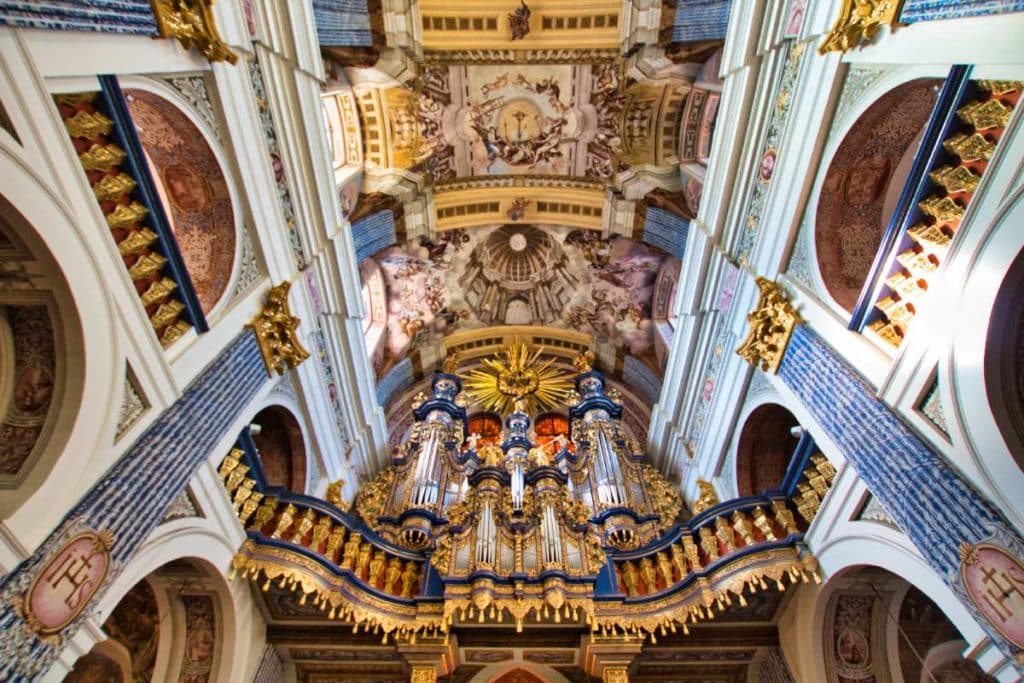
Święta Lipka
Only 6 km away from Reszel there is perhaps the most beautiful church in the north of Poland, a baroque jewel that goes back to an old legend. Once upon a time, in the neighboring Kętryzn, a prisoner is said to have carved a Jesus figure after an apparition to Mary, which was so beautiful that he was released. He hung the figure on a linden tree and numerous miracles occurred as a result. After the first chapel was built, the Jesuits had the church built, which still exists today and is one of the most magnificent that the country has to offer.
The most beautiful way to Święta Lipka
To prevent the citizens of Reszel from getting lost during the rather short pilgrimage across the state border, Bishop Christoph Andreas Johann Szembek commissioned several baroque sandstone chapels along the pilgrimage route in the 1730s, which were built by the sculptor Johannes Frey, who was born in Braunsberg. Frey was considered one of the most important sculptors of the Warmia region and created numerous altars in the region. The 15 chapels, picturesquely embedded in a landscape rich in lime trees, are well preserved and provide a beautiful setting for a short hike from Reszel to Heiligelinde.
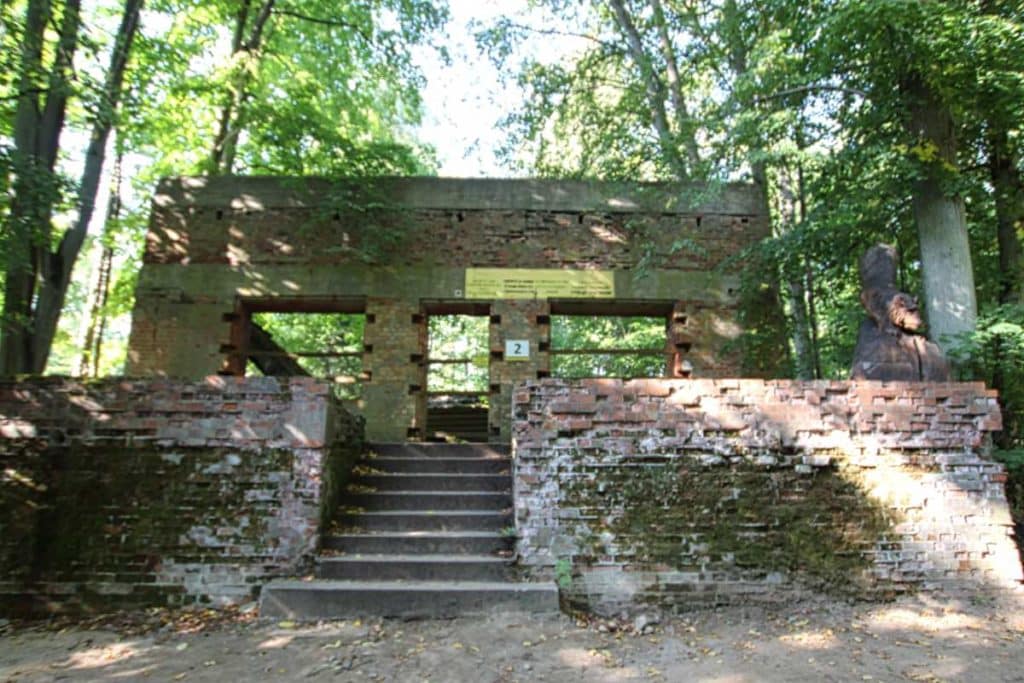
Wolfs Lair (Wolfsschanze)
Deep in the East Prussian forests, Hitler had a monstrous bunker complex built, which he inhabited for almost three years during the Second World War and from where the war in the East was coordinated. The dimensions of the bunker city are almost beyond imagination, meter-thick walls and a secret airport create an eerie atmosphere. This atmosphere is intensified by the fact that the Nazis blew up large parts of the complex when they withdrew and nature is slowly reclaiming the woodland. A few years ago, a museum was finally set up here, so that today, even in German, one can get a lot of information about the history of the plant, where Graf von Stauffenberg once carried out an assassination attempt on Hitler. In a separate article we introduce the Wolfsschanze to you in more detail.

